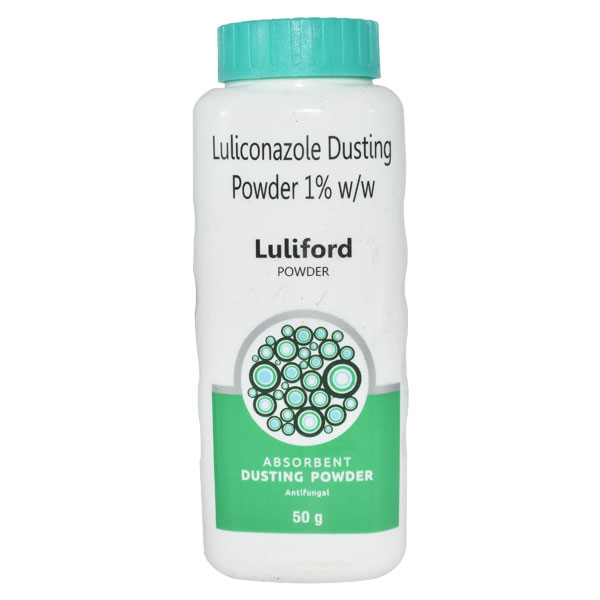
Luliford Dusting Powder
Manufacturer
Leeford Healthcare Ltd
Salt Composition
Luliconazole (1% w/w)
Key Information
Short Description
Luliford Dusting Powder is an antifungal medicine used to treat fungal infections of the skin such as athlete's foot, Dhobie Itch, thrush, ringworm, and dry, flaky skin.
Dosage Form
Dusting Powder
Introduction
Luliford Dusting Powder is an antifungal medicine used to treat fungal infections of the skin such as athlete's foot, Dhobie Itch, thrush, ringworm, and dry, flaky skin. It works by killing the fungi that cause these infections.
Directions for Use
This medicine is for external use only. Use this medicine in the dose and duration as advised by your doctor. Check the label for directions before use. Clean and dry the affected area before application and do not rub.
Safety Information
Side Effects
No common side effects listed.
Alcohol Warning
No interaction found/established
Breastfeeding Warning
Luliford Dusting Powder is probably unsafe to use during breastfeeding. Limited human data suggests that the drug may pass into the breastmilk and harm the baby.
Pregnancy Warning
Luliford Dusting Powder may be unsafe to use during pregnancy. Although there are limited studies in humans, animal studies have shown harmful effects on the developing baby. Your doctor will weigh the benefits and any potential risks before prescribing it to you. Please consult your doctor.
Interacting Medicines
Amisulpride Aripiprazole Chlorpromazine Cilostazol
How it works
Luliford Dusting Powder is an antifungal medication that treats skin infections. It kills the infection-causing fungi by destroying their cell membrane. This relieves discomfort, itching, and irritation on the skin.
Quick Tips
Keep your feet clean and dry particularly between the toes. Cut your nails short and prefer open-toe shoes for everyday use. Use a separate clean towel for the feet and wear clean cotton socks. Never share your socks, shoes, and towel with others. Apply an amount sufficient to cover the affected area and 1 inch of the immediate surrounding skin. It can take a few weeks for the infection to clear and a few months before the skin returns to its normal color. Finish the full course of treatment even if you feel better. It is not taken orally so it does not cause many side effects.
Related Medicines
Frequently asked questions
Is Luliford Dusting Powder safe during pregnancy?
Luliford Dusting Powder is not recommended for use in pregnant women, as there is no data available on its safety in this population. Consult with your doctor if you need to use this product during pregnancy.
What is the fungicidal property of Luliford Dusting Powder?
Luliford Dusting Powder exhibits fungicidal activity by slowing down the growth of fungi, which ultimately leads to the death of these organisms. This effect is achieved by reducing the amount of ergosterol in the cell membrane of fungi.
How should Luliford Dusting Powder be used?
To use Luliford Dusting Powder, apply a thin layer to the affected skin area and spread it to cover at least 1 inch of surrounding skin. Use it once daily for the recommended duration: 2 weeks for athlete's foot between the toes, or 1 week for jock itch or ringworm. Always wash your hands after application.
How long does Luliford Dusting Powder take to work?
The time it takes for Luliford Dusting Powder to be effective varies depending on the condition being treated. For athlete's foot between the toes, results are typically seen 4 weeks after treatment, but may take up to 6 weeks in some cases. For jock itch and ringworm, results are typically seen 3 weeks after treatment, with effects lasting up to 4 weeks.
How should I store Luliford Dusting Powder?
Keep Luliford Dusting Powder in its original container, tightly sealed, and out of reach of children. Store it at room temperature (20°C to 25°C) away from light, excess heat, and moisture.
Is Luliford Dusting Powder safe for use in children?
Yes, Luliford Dusting Powder is safe and effective for use in children aged 2 years or older. The safety and efficacy profile observed in children was comparable to that seen in adults.



